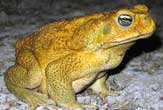
In jokes, the chicken only crosses the road. In Australia, cane toads use roads to travel.
A new study finds that the invasive creatures are using roads to hasten their spread across the continent. The toads take shelter overnight close to the open corridors, then hit the road each evening to continue on their destructive way.
The study, led by Gregory Brown of the University of Sydney in Australia, will be detailed in an upcoming issue of the journal Biological Conservation.
Toad-tracking
Cane toads (Bufo marinus) were brought in from Hawaii in 1935 to control the spread of beetles that were ravaging Australia's sugar cane crop. They're now moving into new territory at the rate of 30 miles a year.
The toads can grow as large as dinner plates and can weigh up to 4.5 pounds. Their heads and backsides are studded with rows of warts that secrete a milky white toxin called bufotoxin, which has been known to kill snakes, lizards and other animals, including pet dogs. They have no natural predators in Australia.
To track the creatures' movements, the researchers strapped radio-tracking devices around the waists of 49 adult toads before releasing them into a test area containing regions of densely packed vegetation as well as more open areas near roads and fences.
Sign up for the Live Science daily newsletter now
Get the world’s most fascinating discoveries delivered straight to your inbox.
The telemetry data revealed that the toads made slower progress through the dense vegetation than along the open spaces and that the creatures hopped alongside the roads and fences whenever possible.
The roads provide long, linear corridors of open habitat that are well-suited for animals traveling long distances and the findings strongly suggest that Australian cane toad are using them to hasten their push into new territory, the researchers write.
Smashing strategies
Another study recently found that the toads have evolved longer legs in recent decades and that this is also helping them in their spread.
Attempts to eradicate the toads have been largely unsuccessful, although scientists reported last year that they had managed to lure and trap the creatures using ultraviolet lights like those used in disco clubs.
The new finding suggests ways to slow down or reduce populations of the pest, the researchers write.
Wildlife authorities could modify road side borders to make them less attractive to the toads, or they could allow dense vegetation to grow along the sides of highways, thus "forcing toads onto the road itself, thereby increasing their vulnerability to vehicular traffic."
- Image Gallery: Invasive Species
- Toxic Toads Evolve Long Legs and Take Over Australia
- Invasive Creatures Attack Like Internet Viruses
- Amphibians Hang Out in New Tree of Life
- Who Will Pay to Save the Frogs?









